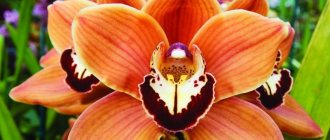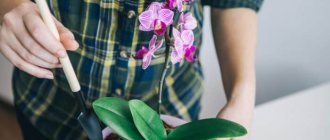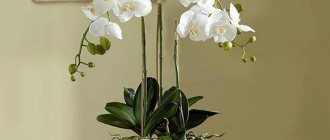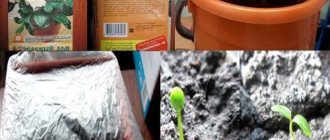Features of caring for plants intended for sale
Often the flower is not maintained properly at the point of sale. The interior flora of the store may contain fungi and pests, and if the orchid has been in such a room for several days, it is no longer healthy.
First of all, when purchasing, find out how long ago the flower was imported, and also look at the conditions in which the plant is kept.
Plant conditions:
The shelf on which the flower pots are located in the store must be dry and clean.
In addition, there should be no water in the tray where the orchid pots are installed. Containers with plants must be transparent and have numerous holes for ventilation of the roots. Pay attention to the moisture content of the substrate, as the plant will better tolerate relocation and adaptation if it is not watered.- Another nuance is the presence of a special tag, which will indicate under what conditions the species should be kept and its name.
- Along with the flower, you should buy a mixture for replanting. It is worth understanding that materials that retain moisture, such as moss, are often placed in pots for transportation. And if it is not removed in time, the roots may soon rot.
When buying flowers in a large supermarket, you should be very careful, since it is in these places that the plants practically do not receive proper care - there are often no qualified florists there.
Read more about how to properly care for an orchid in a separate article.
Miltonia
It belongs to a variety of hybrid plants; its bud looks more like a violet. The flower is easy to care for, but it is not recommended to keep it in a room with high temperatures and dry air.
For full growth and development of miltonia, regular watering is required, and air humidity should not be less than 80-85%.
The flower does not like direct sunlight. A sharp change in temperature should not be allowed, otherwise miltonia may die.
What to look for when making a decision?
To purchase a healthy flower, you need to pay attention to the following nuances of choice::
- We carefully examine the orchid - the foliage should be healthy, without spots, damage or wilting.
- We inspect the peduncle - it is better to buy plants that will have not only blossoming flowers, but also buds. It is this fact that will allow you to admire the flowering for another month and a half after purchasing the orchid.
- We inspect the roots - if they are brown, it is better not to buy the plant.
Zygopetalum
The plant has large flowers with a pleasant smell. Most often found in Paraguay, Mexico and Peru.
Zygopetalum easily takes root both on the ground and on rocky soil; it can also be seen on trees.
The temperature in the room where the flower grows should not exceed +25 degrees. Air humidity should be at least 50%.
In summer, zygopetalum needs constant spraying. Does not require additional lighting, takes root well in the south-eastern and eastern parts of the apartment.
Step-by-step instruction
Which flower lover doesn’t want to know how to choose the right orchid, and it doesn’t really matter whether the flower is bought as a gift or to take home. Let's take a closer look at what you should pay special attention to when purchasing.
Inspection of roots
The most important part of an orchid is the roots , since in addition to feeding the plant and moisturizing the leaves, they are involved in photosynthesis.
Healthy roots are light green if the substrate is dry, and dark green if the flower is watered.
When examining the plant, gently pull the rosette ; if the roots are healthy, you will feel resistance, in which case you can choose this specimen.
Appearance of leaves
When examining the foliage, it is sometimes difficult to determine the health of any type of orchid, since the color of the upper part can vary greatly among different varieties. In this case, it is worth paying attention to the color saturation - the leaves are thick, fleshy, glossy with a bright color - the plant is overfed with fertilizers and it will not bloom.
Inspect the growing point; there should be no damage on it . Also, there should be no wet spots or lesions on the foliage.
Peduncle condition
Often the choice falls on a beautifully flowering plant. Therefore, carefully examine the peduncle. It is better to buy a crop that, in addition to flowers, also has unopened buds.
Flowers should not only be bright, but their foliage should also be resilient. It is better not to buy an orchid with wilted flowers.
Signs of disease or pests
Signs that may indicate orchid diseases:
- coating on leaves in the form of fluff;
- spots on leaves of different sizes are brown or black;
- wet ulcers;
- brown roots;
- rotten growing point.
Insects may appear on the flower; signs of damage are as follows::
- growths and tubercles on the inside of the leaf are infestation with scale insects;
- cobwebs on the leaves - spider mites;
- a silvery film coating on the inside of the leaf is thrips;
- the roots are damaged - they were eaten by polygons;
- holes in the leaves are midges.
How to bring an orchid home correctly?
The orchid does not tolerate drafts at all, regardless of whether they are cold or vice versa. In this regard, you need to take it home carefully packed. Regular wrapping paper or newspaper folded in several layers works well for this. The orchid fears heat no less than cold. Therefore, it is important to think carefully about the time of purchasing a flower and the method of delivering it home.
Choosing the type of orchid to grow in an apartment is a very responsible process. After all, only healthy plants are able to form a large number of exquisite flowers and decorate the interior of your room. In the guise of an amazing orchid, all the beauty and grandeur of nature appears, with its splendor of colors and shapes. Truly, the creator who created this magical orchid was wise!
Flowering period
It’s hard to pass by a blooming orchid; you immediately want to buy it and take this splendor home. The advantage of such a purchase is the fact that you can immediately see what color the buds will be. But it is worth knowing about some of the risks that may lie in wait when purchasing a flowering plant.
During flowering, an orchid gives a lot of strength and energy to its inflorescences . For example, Phalaenopsis can bloom for several years in a row and then die. So it turns out that if a plant went on sale blooming and stood there for a long time without going into dormancy mode, then it may die after purchase (learn about how to care for an orchid after it blooms and what to do to make it bloom again , available here).
Phalaenopsis
Phalaenopsis is popularly called the flower for beginners. Its homeland is the Philippine Islands, but despite this, phalaenopsis takes root well in the conditions of the middle zone.
The duration of flowering is up to 3 months, and the favorable room temperature for it is from +18 to +25 degrees. The plant loves bright sunlight; if there is a lack of it, additional lighting is necessary.
In summer, the orchid must be watered no more than twice a week, and in winter, watering must be reduced, focusing on the condition of the soil. The orchid has a fragile root system, so it can be replanted no more often than once every 3 years.
Substrate and pot: what should they be?
You came to the store to buy an orchid, what should your eyes first fall on:
- If the roots of the plant are in moss, then it should be fluffy, not crushed and preferably dry.
- If there is a soil mixture in the pot, then you should pay attention not only to the composition of the substrate, but also to its moisture content - the plant should not be over-moistened.
- The pot should be transparent, since thanks to the roots involved in photosynthesis, the plant develops and blooms better.
In addition, you can calmly inspect the plant and assess the condition of the roots .
What time of year is best to make a purchase?
An orchid is an overly delicate flower; transportation during the cold season is contraindicated for it. She may become hypothermic or even freeze. If it is not possible to wait for warmer weather, it is advisable to take care of transporting the orchid in advance. In this case, take various insulation materials (thermal bags or plastic bottles with hot water) with you to the store, then it is possible to deliver the flower home unharmed.
On the eve of March 8, sellers often organize a wide sale of flowers on the street. You should absolutely not buy an orchid from these sellers. Such a flower will not survive at home for even a couple of days, dying from sudden temperature fluctuations.
Where can I buy a healthy plant and how much will it cost?
Nowadays you can buy an orchid at any retail outlet that sells flowers, but if we talk about a healthy plant, it is better to go to a special greenhouse. This is where specialists who know their business work.
Professional sellers will not only give advice on the plant’s agricultural technology, but will also select an orchid variety that will feel great in a single apartment.
Flowers grown in specialized greenhouses are much more resistant to diseases and viruses and resist pest attacks well.
It is in this place that proper care is organized for them, and the habitat is as close to natural as possible (we talked in detail about where orchids grow in nature and how they are classified in this article).
Another reason to go shopping in a greenhouse is the huge selection of varieties and species of this exotic plant (you can learn more about rare and unusual varieties of orchids here).
No flower shop can offer you such a wide variety of flowers. The cost of orchids in a greenhouse will be 890-4,000 rubles, depending on the variety, type, and delivery method.
Where can I buy an orchid
It’s quite easy to choose a phalaenopsis orchid in specialized stores or shopping centers, where professionals will tell you in detail what kind of care is required indoors. Take this matter very seriously, ask additional questions if necessary.
Be sure to ask where the plant was before it came to the store. It would be ideal if this place turns out to be a greenhouse - there the humidity is correctly selected, the light, and the ventilation meets the standards.
Choosing an orchid in a store will not be difficult, but it is more interesting to purchase this flower at exhibitions, where there is a chance to communicate personally with a florist who grows phalaenopsis on his own.
Consequences of a bad choice
Often newcomers to floriculture say that as soon as a beautifully flowering orchid entered an apartment, it dropped its flowers and died over time, while proper care was provided for it.
This may be the consequences of choosing the wrong plant in the store. From there you brought a plant that was sick or infected with parasites. As a result of stress, the plant's weakened immunity cannot withstand it and the plant dies .
Which orchid to choose
To choose the right orchid, you should be guided not only by the attractive appearance of the flower. It is very important to know whether the room conditions meet the requirements of the orchid you have chosen.
It is worth taking into account all the complexities of agricultural technology and the selected plant. As well as the size of the plant, you need to determine in advance whether there will be enough space in the apartment for your green friend.
When growing orchids at home, the main factors in their maintenance are lighting and temperature. If you cannot provide the orchids with additional lighting in winter with fluorescent lamps, then you should abandon light-loving species, for example, cattleya.
In order to choose the right orchid when buying, you need to know that plants can be brought from abroad. Such orchids are sold in containers for transportation using a lightweight substrate. Currently, orchids are brought from Western Europe in March-September.
If you chose a foreign orchid when purchasing, then after purchasing the plant, be sure to keep it for three to four days separately from other indoor flowers.
This time is quite enough to carefully monitor the orchid for all kinds of pests and diseases. Do not forget to water the flower. After quarantine, and if the results are positive, you can begin further care of the orchid.











